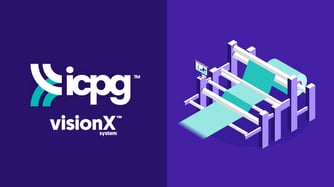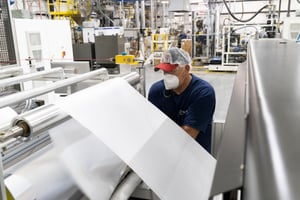 Whether you are processing on a thermoforming machine or a Form Fill Seal line, precise gauge control and layer thickness monitoring for multi-layer coextruded barrier rollstock structures is critical to ensuring that your packaging is cost effective, meets the designed performance objectives and is as environmentally sustainable as possible.
Whether you are processing on a thermoforming machine or a Form Fill Seal line, precise gauge control and layer thickness monitoring for multi-layer coextruded barrier rollstock structures is critical to ensuring that your packaging is cost effective, meets the designed performance objectives and is as environmentally sustainable as possible.
Controlling the overall gauge, or thickness, of a rollstock structure is a thermoformer's first line of defense in maintaining cost effectiveness, as gauge control directly correlates to maximizing the amount of thermoformed parts yielded from a given amount of rollstock purchased. Effective gauge control also ensures that the processor can optimize production, minimize waste, and deliver packaging with consistent quality.
But, when working with multi-layer coextruded rollstock structures, controlling and verifying the thickness of individual layers is just as important.Tight gauge control prevents overuse of costly barrier layers, helping to reduce material costs while ensuring compliance with shelf-life specifications.
The Impact of Gauge Control on Food Packaging Design
Designing packaging to effectively protect shelf stable foods is a challenging task as protection, spoilage, distribution, efficacy and so many other factors must be carefully considered. These challenges are made exponentially more difficult if a processor cannot rely on their rollstock partner to effectively control layering and deliver the right amount of performance.
Understandably, if the best rollstock performance isn't always delivered, designers may feel the need to over-engineer rollstock structures, using more plastic and more expensive barrier materials than necessary. While this may protect shelf-life performance, it also increases material costs, creates operational inefficiencies, and slows down production.
Gauge Control and Packaging Sustainability
 Additionally, industry-wide concerns regarding the sustainability of plastic food packaging solutions remain at the forefront. While designing rollstock for manufacturability is important, it has become increasingly more important to processors and end-use consumers to ensure that packaging is designed for sustainability & recyclability.
Additionally, industry-wide concerns regarding the sustainability of plastic food packaging solutions remain at the forefront. While designing rollstock for manufacturability is important, it has become increasingly more important to processors and end-use consumers to ensure that packaging is designed for sustainability & recyclability.
For multi-layer barrier structures current recyclability guidelines require less than 10% EVOH content. The practice of adding excess plastic materials is in direct conflict with industry-wide initiatives to reduce carbon footprint.
Working with a rollstock supplier with the capability to precisely control barrier layers will ensure your packaging is recyclable, compliant, and optimized for material efficiency.
ICPG’s visionX Gauge Control System
ICPG’s proprietary visionX system has been implemented to control not only the overall gauge of the rollstock structure, but also the individual-layer thickness of the material as it is being produced. With real-time data analysis powered by electromagnetic wavelength technology, visionX delivers a level of accuracy unattainable with conventional technologies, including:
- Precise layer control to reduce overuse of barrier material
- Real-time monitoring for consistent production quality
- Sustainability improvements by reducing excess plastic
- Stronger quality assurance with tighter specification control
Ready to Improve Gauge Control?
Interested in learning more about how advanced gauge control systems like visionX system can simultaneously improve sustainability, reduce costs, and deliver better-performing multi-layer barrier food packaging?
Contact ICPG today or download our solutions brochure today: to explore how our technology can support your packaging goals.




